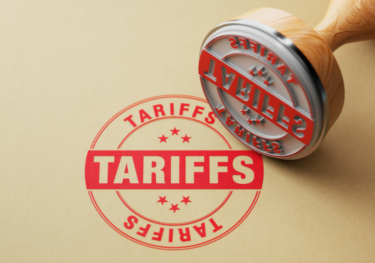What are tariffs good for?
Higher US tariffs will prove sticky.
Cutting through all the noise and uncertainty around trade policy, tariffs being paid by importers are still increasing sharply. We expect high US tariffs are the new norm and will prove difficult for future administrations to reverse.
What is the aim of trade policy?
A lot of the uncertainty around trade policy comes from the fact that the Trump administration has offered multiple, often conflicting, explanations of trade policy. Raising revenues, reducing the trade deficit, using them as a negotiation tool to open foreign markets, and contributing to reshoring America’s industrial production for national security reasons.
Tariffs are proving more effective at reaching some of those goals than others.
Can tariffs increase government revenue?
Yes – and faster than any other tax change now on the books.
When the White House rolled out the universal 10 % tariff in early April 2025, the most immediate effect has been fiscal. Customs receipts jumped from an annualized $79 billion in 2024 to roughly $320 billion by June 2025, lifting tariff revenue to about 1.1 % of GDP — quadruple last year’s share.

Customs duties are now the federal government’s fourth‑largest revenue stream, trailing only income, payroll, and corporate taxes.
We project that if the 10 % duty stays in place and the other higher rates faced by China and select industries are maintained, tariffs would add roughly $2.5 trillion to federal coffers over the next decade — enough to offset much of the revenue loss from the One Big Beautiful Bill’s tax cuts.
As long as Washington needs cash (and deficits remain stubborn), the 10 % blanket tariff is likely to outlive the administration that created it.
Can tariffs reduce the trade deficit?
Yes – but only because imports will shrink by more than exports.
Tariffs tax imports, making foreign goods more expensive for US buyers, so imports fall. Exports, meanwhile, slip by less because foreign retaliation has been milder and more targeted than feared. The result in our forecast: the goods‑trade gap narrows by roughly 0.4 percent of GDP by 2028.
Two mechanisms matter most:
- Fiscal channel. The extra revenue means the overall federal deficit is smaller than it would otherwise be, which dampens domestic demand and trims import appetites.
- Asymmetric retaliation. Trading partners have not matched the United States tariff one for one. On average, the U.S. now imposes a higher duty on incoming goods than its exporters face abroad, reversing a decades‑long pattern of comparatively open American markets.
Unlock exclusive economic and business insights—sign up for our newsletter today
Subscribe
Are tariffs generating a lot of leverage?
Maybe – but they are failing at opening foreign markets.
President Trump touts tariffs as a successful dealmaking tool, creating leverage over foreign partners. When it comes to the economics, though, tariffs have been ineffective at convincing others to drop trade barriers to US firms.
The trade deals announced so far have been about curbing the most damaging aspects of policy, with little in the way of market opening for US firms. If anything, US exporters face slightly higher trade barriers in other countries today than before the election, thanks to the retaliation measures imposed by others.
Do tariffs protect domestic industries?
No – at least not yet, and not without collateral damage.
The legal scaffolding for most of the new duties rests on a sweeping national‑security declaration. In theory, raising the cost of imported steel, semiconductors, or active pharmaceutical ingredients should nudge factories back onshore. In practice, the story is murkier:
- Investment head‑wind. Tariffs raise the price of imported capital goods. For manufacturers higher equipment costs mean a squeeze in margins, or causes them to defer or cancel expansion plans at home.
- Policy whiplash. Firms investing on long time horizon crave stability. When tariff rates swing with presidential proclamations, the incentive to reshore is undermined.
- Retaliatory roadblocks. U.S. exporters selling precision parts, farm commodities, and services abroad now face the prospect of higher barriers, undercutting the very scale economies that help support domestic production.
Even in sectors of clear strategic interest — think chips — the heavy lifting comes from targeted subsidies and the CHIPS and Science Act, not from tariffs alone. Our forecast for U.S. industrial output in 2028 is lower than it would have been in a no‑tariff world.
Why revenue success makes tariffs “sticky”
Because the president can impose or remove duties without asking Congress, tariff policy can flip overnight. But once a tax starts delivering hundreds of billions, scrapping it becomes politically risky. According to a White House fact sheet announcing the emergency proclamation, tariff income is earmarked to “strengthen our national and economic security.” That framing makes the 10 % levy more than a bargaining chip; it’s a budget line.
Future administrations could lower rates, but they would have to fill the hole with some combination of higher domestic taxes, deeper spending cuts, or bigger deficits. None is painless, so the path of least resistance is to keep the universal tariff.
Key takeaways for businesses and consumers
- Higher tariffs are a feature, not a bug. Revenue goals require a broad base; that suggests exemptions will be limited and rates could continue to rise from here.
- Supply‑chain rewiring beats waiting it out. Firms that can diversify sourcing or take advantage of U.S.–Mexico–Canada rules of origin will fare better than those betting on blanket roll‑backs.
- Policy stability is elusive. Presidential control means tariff headlines will keep coming. Build flexibility – and scenario analysis – into strategic plans.
Conclusion
The universal 10 % tariff has achieved one thing decisively: it pours cash into the Treasury faster than any post‑war revenue move short of an income‑tax hike. It does shave the trade gap, though mostly by suppressing imports. What it has not yet done is open foreign markets or breathe new life into domestic manufacturing. For now, tariffs are less an industrial strategy than a fiscal one – and that is why they may prove harder to unwind, including for future administrations.
What to watch next
- August 1 deadline. The suspensions of extra duties on dozens of countries expire. If talks stall, surcharge rates could jump overnight.
- August 12 US–China cease‑fire cliff. The reciprocal‑tariff pause lapses, with both sides threatening step‑ups as high as 40 %.
- Sector probes. Ongoing investigations into lumber, semiconductors and pharmaceuticals may bring new 25–50% tariffs at any point over the next six months. Trump has floated rates as high as 200%.
Would like to learn more about how we measure the effectiveness of tariffs? Download our report, “What is the Endgame for US Tariffs?”, for a deeper dive.
Subscribe to our newsletters
Tags:
Related Reports

What is the endgame for US tariffs?
We think it's likely that high and broad-based tariffs are here to stay because, of all the purported goals of trade policy, they're proving most successful at raising revenue.
Find Out More
The US immigration surge comes to an end
The net immigration into the US has slowed more abruptly than anticipated in the early days of Trump's second presidency. Could this be the start of a new chapter in US immigration?
Find Out More
Industrial recession still expected due to global tariff chaos
Tariffs spark uncertainty in the global industrial sector, raising recession risks. What’s next for businesses? Discover insights from Oxford Economics.
Find Out More
Impact of the Iran-Israel escalation on oil prices
Surging crude oil price from Iran-Israel conflict puts global GDP at risk. Is the world economy on the edge of another downturn?
Find Out More
